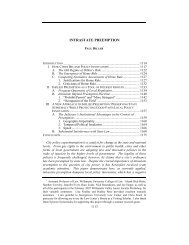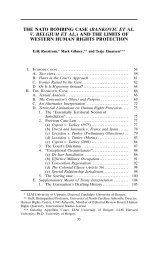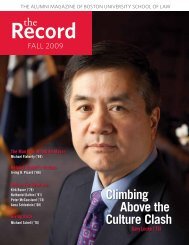the nature of representation: the cherokee right ... - Boston University
the nature of representation: the cherokee right ... - Boston University
the nature of representation: the cherokee right ... - Boston University
Create successful ePaper yourself
Turn your PDF publications into a flip-book with our unique Google optimized e-Paper software.
2005] THE NATURE OF REPRESENTATION 115<br />
diminish <strong>the</strong> leadership <strong>right</strong>s <strong>of</strong> Ross and o<strong>the</strong>r chiefs, as did questioning whe<strong>the</strong>r<br />
such leaders really were Cherokees. 129 During <strong>the</strong> summer before <strong>the</strong> negotiations,<br />
The Federal Union wrote that Cherokee leaders “have a large proportion <strong>of</strong> white<br />
blood in <strong>the</strong>ir veins.” 130 The U.S. government was not alone in such racial<br />
questioning. The rival Cherokee leader John Ridge expressed as much when he<br />
defended <strong>the</strong> New Echota Treaty by writing:<br />
[A] few men, at <strong>the</strong> head <strong>of</strong> whom is John Ross, who is nearly a white man in<br />
color and feelings, have affected to be <strong>the</strong> “constituted authority” in <strong>the</strong><br />
nation, by holding councils in <strong>the</strong> frontier <strong>of</strong> our nation in <strong>the</strong> form <strong>of</strong> a<br />
committee and council <strong>of</strong> his friends, who have used up all <strong>the</strong> Cherokee<br />
annuities, and exhausted <strong>the</strong> credit <strong>of</strong> <strong>the</strong> nation, under <strong>the</strong> pretence <strong>of</strong><br />
defending and saving <strong>the</strong> Cherokee lands. 131<br />
The similarity between Ross and U.S. agents in terms <strong>of</strong> manner, physical features,<br />
and perhaps corruption was used to support <strong>the</strong> democratic idea. These criticisms<br />
are ironic, however, considering that <strong>the</strong> tribal government was based upon <strong>the</strong><br />
U.S. model and <strong>the</strong>ir leadership was comfortable navigating <strong>the</strong> U.S. capital.<br />
4. Cherokee Resistance to Removal<br />
The Cherokee resistance to removal goes a long way toward explaining <strong>the</strong><br />
charges against <strong>the</strong> Cherokee leaders and <strong>the</strong> calls for a democratic treaty<br />
negotiation and ratification. According to President Jackson, <strong>the</strong> rejection <strong>of</strong><br />
removal treaties by Cherokees “has been owing more to <strong>the</strong> ascendancy acquired by<br />
individuals who are unwilling to go, than to <strong>the</strong> deliberate opinion <strong>of</strong> a majority <strong>of</strong><br />
<strong>the</strong> Cherokee people.” 132 A viewpoint similar to Jackson’s can be found in<br />
Schermerhorn’s journal: “The people generally were very anxious to have <strong>the</strong>ir<br />
difficulties settled, although <strong>the</strong>y were deterred from attending on account <strong>of</strong> <strong>the</strong><br />
influence and fear <strong>of</strong> some <strong>of</strong> <strong>the</strong>ir chiefs.” 133 Schermerhorn later accused Cherokee<br />
129<br />
See e.g., John Bell (Whig-Rep. <strong>of</strong> Tennessee to U.S. House <strong>of</strong> Representatives),<br />
House Debate on <strong>the</strong> Removal <strong>of</strong> <strong>the</strong> Cherokees, (Feb. 14, 21, 1831), in 2 THE<br />
AMERICAN INDIAN AND THE UNITED STATES, supra note 29, at 1187 (“It was not <strong>the</strong> red<br />
men who were benefited under <strong>the</strong> present system, but some twenty or thirty whites who<br />
had insinuated <strong>the</strong>mselves into <strong>the</strong> confidence <strong>of</strong> <strong>the</strong> Indians, and who, toge<strong>the</strong>r with<br />
<strong>the</strong> half-breeds, controlled <strong>the</strong> whole tribe, and acquired wealth at <strong>the</strong> expense <strong>of</strong> those<br />
for whose welfare so many philanthropic wishes were expressed in <strong>the</strong> House.”).<br />
130<br />
THE FEDERAL UNION,July23,1834,at3. 131<br />
Letter from John Ridge and S. Watie to John F. Schermerhorn, U.S. Commissioner<br />
(Feb. 26, 1836), in TREATY WITH THE CHEROKEE INDIANS, 24th Cong., 1st Sess., 46-49 at<br />
46.<br />
132<br />
Presidential Message on <strong>the</strong> Treaty with <strong>the</strong> Cherokee Indians, S. Exec. Doc. No.<br />
7, 23rd Cong., 1st Sess., 1-2 at 1.<br />
133<br />
A journal <strong>of</strong> <strong>the</strong> proceedings <strong>of</strong> <strong>the</strong> Council held at New Echota, Georgia Dec. 21-<br />
30, 1835, with <strong>the</strong> Cherokee people by John F. Schermerhorn, Commissioner on <strong>the</strong> part<br />
<strong>of</strong> <strong>the</strong> United States to treat with <strong>the</strong> Cherokees east, in TREATY WITH THE CHEROKEE









